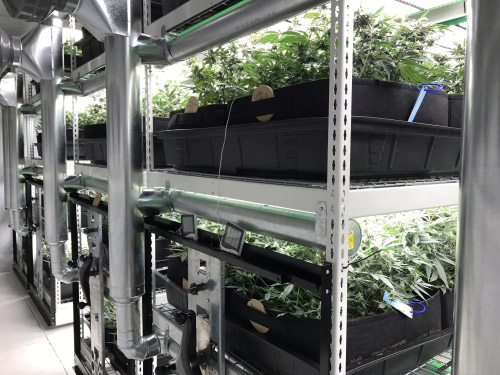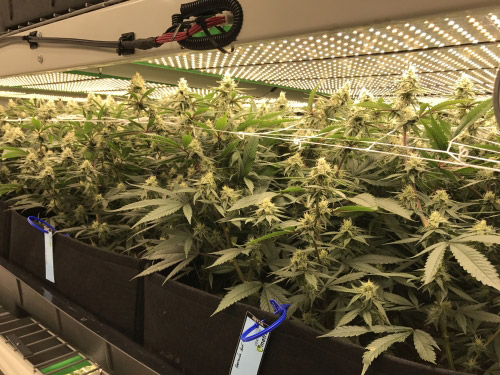








Smart Grow Systems has announced the Goldeni LED horticultural lighting system that is intended for optimizing propagation and flower cycles in vertical-farming installation for crops such as cannabis, orchids, hops, and berries. In such crops, increased biomass is the typical goal of growers and Smart Grow Systems claims that Goldeni will produce more biomass, support faster cycles, and more effectively use space.
As we have written previously such as in a feature article last fall, solid-state lighting (SSL) is being used in two primary scenarios for horticulture. In crops such as tomatoes or cannabis where biomass is the goal and crops generally grow tall, LED or legacy lights are installed well above the plant canopy and serve as the primary radiometric energy source indoors or as a supplemental source in greenhouses. In crops such as leafy greens and herbs, the latest movement is to vertical farms where many racks of plants are stacked and in which the LED lighting is placed very near the plant canopy.
For applications such as legal medicinal or recreational cannabis, most of the LED lighting manufacturers targeting such growers have mimicked the form factor of the high-intensity discharge (HID) lamps used in such applications. Round horticultural lighting fixtures have been mounted well above the plants with a single fixture providing the needed energy to a small group of plants. The physical layout of such growing operations has been dictated by the effective beam spread of the lamps and the fact that heat generated by the lamps prevents location near the plant canopy.

Smart Grow Systems’ Goldeni horticultural lighting systems can be configured in close arrangements for vertical crops in order to achieve more biomass and quicker growth cycles.
In vertical farms, LED-based lighting doesn’t deliver problematic heat, which allows the dense stacking of layers, and crops such as lettuce or herbs are stacked very closely. In the grow operations envisioned by Smart Grow Systems, the growers will use a hybrid of the two. The operations will require more space than herbs or leafy greens like lettuce. But Smart Grow Systems believes that cannabis, hops, orchids, berries, and more can be effectively grown in layers with, say, 3 ft of spacing, or as little as 28 in., between the layers.
So Smart Grow Systems announced the 2×4-ft Goldeni systems, making direct comparisons to HID sources such as metal halide (MH) and high-pressure sodium (HPS) grow lights. Indeed, the Goldeni system does not include the monochromatic red and blue LEDs typically found in luminaires for vertical farms but rather includes LEDs that deliver energy across the PAR (photosynthetically active radiation) spectrum just as HID sources do. And some growers seeking biomass have made the point that red and blue alone will not optimize yield in fruiting plants.
A revolution is happening in horticulture. It’s a seismic shift that will change fundamentally how we grow plants — and it’s all down to lighting. The next Horticulture Lighting Conference will take place in Denver, CO on Tuesday, October 17, 2017. To find out more information and to register to attend please click here.
“Smart Grow believes the future of many commercial crops will be vertical farming in a sea of green application, and we are focused on building a comprehensive vertical farming system to maximize biomass production in the available space of any commercial indoor grow operation,” said Darrin Dow, founder and CEO of Smart Grow Systems. “Smart Grow has started with ultra-efficient lighting, digital controls, and consulting services that help growers understand the biomass potential of their grow spaces: how much sellable, high-quality crop can be grown in a space when the grow area is stacked up to the ceiling.”
The company has further developed different versions of the product for different stages of the production cycle. The Goldeni luminaires produce what is called a Baby Blue Spectrum that is intended for cloning and propagation. The standard Goldenix fixture has what the company calls the Golden Glow Spectrum that in the case of cannabis produces what the company says are “resin-rich crops with exceptional terpenes and trichomes.” Both product types generate what appears to be white light.
John Sidline handles marketing for Smart Grow Systems, and he described a case study from the legal cannabis operation at Deschutes Growery in Bend, OR. The grower had previously used 15×18-ft rooms in which 15 plants were clustered in a 4×4-ft area under a 1000W HPS light. The eight clusters in one room generated $162,000 per year based on three 16-week growth cycles and each plant producing 1.25 to 1.5 lb of product.
An LED-retrofitted room utilizes six 4×8-ft shelfing systems per room, each with four decks or layers. The plants are grown only for 7–9 weeks, yet THC and terpine levels have increased relative to HPS-lit rooms, making the yield more valuable. The LED-lit room is on track to earn $225,000 for each of six cycles in a year, according to Sidline. Meanwhile, the power consumption and HVAC costs have been reduced significantly. You can watch a short video below demonstrating the lighting configuration in a growing operation.
“By switching to vertical farming with Smart Grow’s new Goldeni lights, Deschutes Growery has been able to increase our yields by at least 400% per harvest inside the same space, and have reduced our carbon footprint by more than 50%,” said Dylan McMahon, engineer at Deschutes. “Deschutes Growery has been looking to retrofit our inefficient high-intensity HPS lighting for a while but haven’t been able to find the right LEDs that maintain our standard of quality until we found Goldeni. Smart Grow LED grow lights, in conjunction with our vertical farming system, make best use of our grower’s producer license by allowing us to maximize our canopy size without adding real estate.”
Of course, there is more that can be done with LED-based lighting. Smart Grow’s Sidline notes that the company has used remote drivers to eliminate all heat from the plant area, enabling location of LEDs near plants. Similarly, growers can use flexible interlighting LED products to get light to the lower portion of plants with dense canopies as we discussed in our article on the LEDs Magazine Horticultural Lighting Conference last year. We are also planning our Horticultural Lighting Conference for the fall of 2017. We recently published some results from our recent European Horticultural Lighting conference. And you can find a collection of horticultural information on our microsite focused on the topic.
Copyright 2006-2025 Shanghai Sinoexpo Informa Markets International Exhibition Co., Ltd. All rights reserved